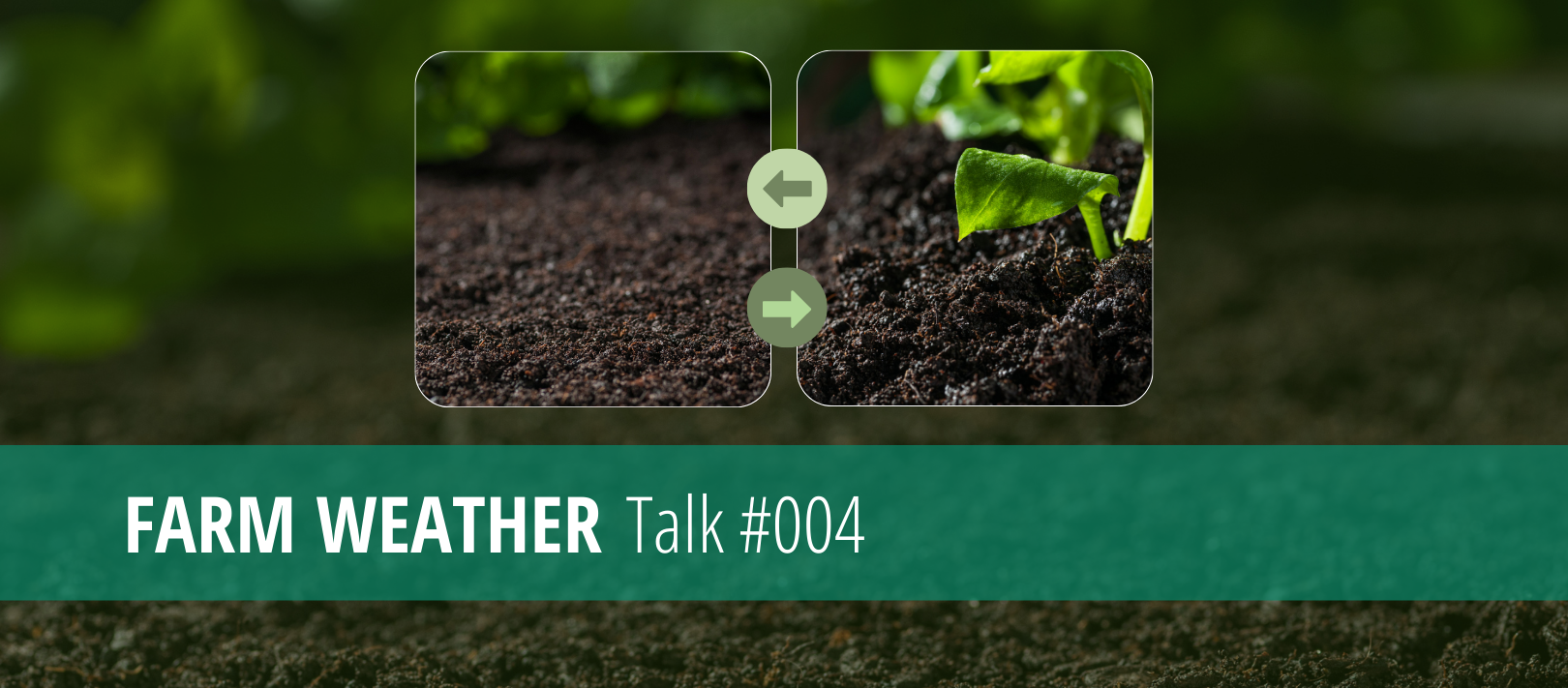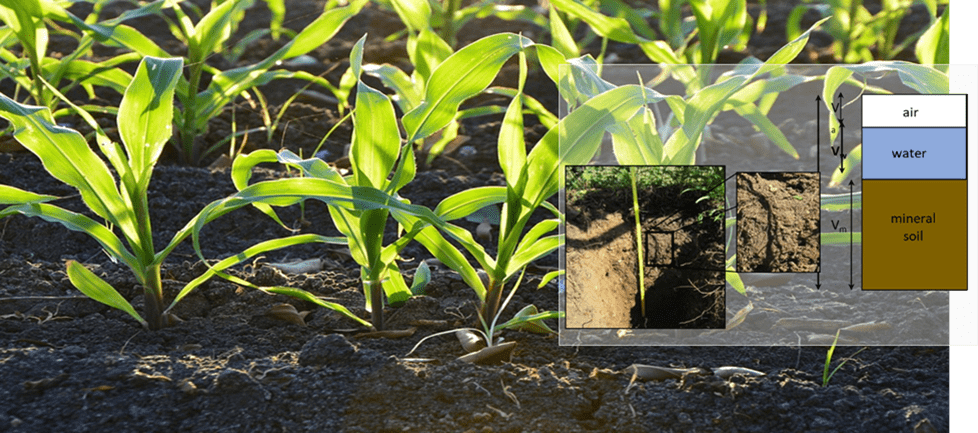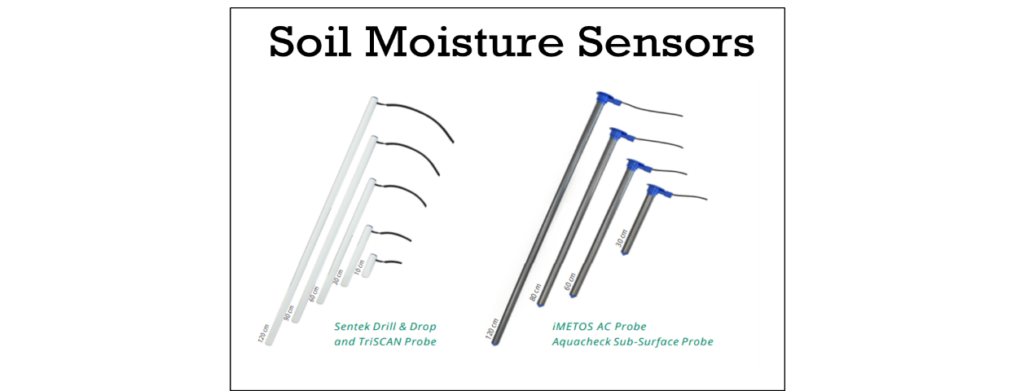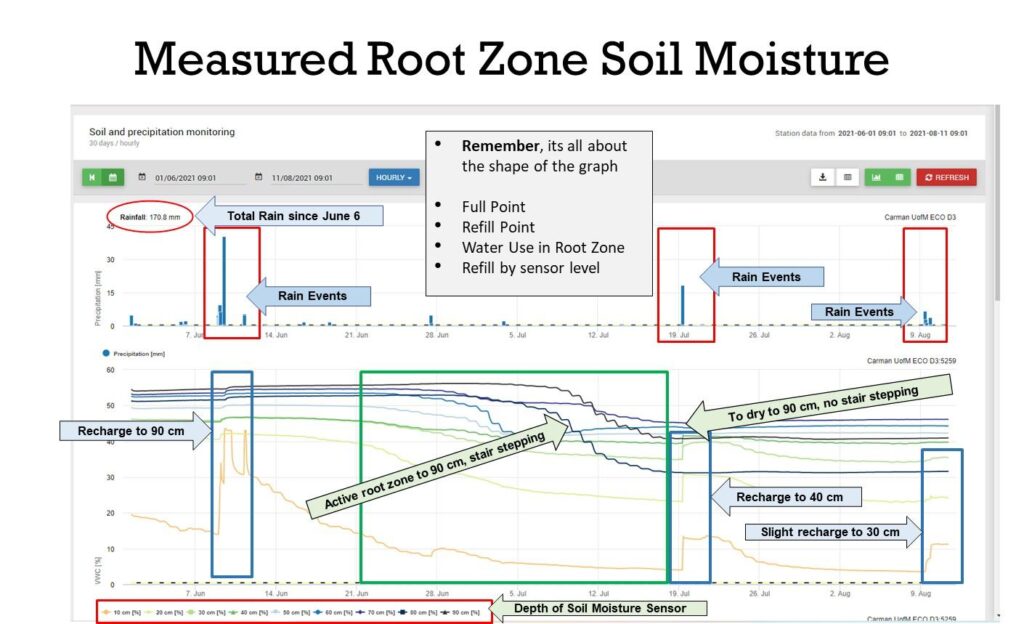Dig into how a weather station or IoT device with a soil probe can be used in a real farming example (soil moisture) to maximize returns.
Soil Moisture – the Crops Gas Tank
In the third installment of Farm Weather Talk, we discussed the benefit of yield prediction and satellite imagery and why they are a must for nutrient management. In this installment we are going to dig into how a weather station or IoT device with a soil probe can be used in a real farming example of soil moisture to maximize returns.

Background
As the winter season sets in for many of the northern locations in the northern hemisphere, thoughts are not far off for planning next year’s crop. As we have discussed, knowing how much soil moisture you have in a profile is very important, since it determines how much “gas you have in the tank”, in other words, how much soil moisture is there for crop development next spring. If you know you only have 125 mm (5 inches) of stored water versus 225 mm (9 inches) of stored water in a different soil profile, you are going to manage nutrients and the crop differently. In addition to subsurface moisture, the over winter snowpack can provide much needed moisture for the seed bed and hence germination.
This is why it’s very important after the crop has been harvested to have fall rains or wet snow, since this is the time for recharge of the soil (fill the gas tank for next year). If you go into the fall with a “low gas tank”, then the potential for a lower yield next year is a higher risk. It should be noted that snowpack in many locations does not add a lot to store subsurface soil moisture levels, but it does help seed bed levels and dugouts.
So how do you determine how much soil moisture is stored in your various fields?
You really have no idea by looking at the surface of the fields, just kicking the dirt gives you a guess. You need to either take a soil core and use the hand squeeze method or use a soil probe to determine how much is stored in the profile.

Common Types of Soil Probes
For soil probes there are a couple good options that can be connected to an in-field IoT device. The first is the Drill & Drop Triscan Probe from Sentek, and the second is the Aquacheck probe.

Slightly more advanced than a rain gauge and the boot test, the Sentek Drill & Drop probe uses capacitance-based technology to provide a volumetric measurement of soil moisture, temperature, and volumetric ion content (VIC) or salts at multiple depths along a soil profile. It’s available in 10-cm, 30-cm, 60-cm, 90-cm and 120-cm lengths with sensors fixed at every 10-cm increment. The Aquacheck probe uses the same technology but provides only soil moisture and soil temperature measurements.
Obviously, a soil probe provides a much more accurate reading of your entire soil profile’s moisture content, than the traditional methods. By having this information, you can make informed decisions on crop inputs throughout the season and at critical periods of seeding and fertilizing stages, plus knowing your soil salinity and temperature helps you with other agronomic decisions.
In the illustration below which is using a Sentek 90cm Triscan probe, you can clearly see when rain infiltrates each soil layer from shallow to deeper, how much each layer increased and the time it took from the start of the rain event to reach each layer. You can also “see” where the roots are extracting soil moisture from, referred to as stair stepping or day/night evapotranspiration, and how the roots grow over time to reach deeper soil moisture.

If you are using an in-field weather station to connect your soil probe, then the IoT device can be used for many field specific applications. It’s a holistic approach: monitoring real-time precipitation, relative humidity, leaf wetness, wind speed/direction, spray conditions, field level weather forecasts, alerting, disease models, yield prediction and the list continues to grow. With so many new data utilization products coming out, growers have access to a lot of solutions that simply didn’t exist before.
As more farm data is collected, the information needs to be turned into profits or a higher ROI, and this can be done through easy-to-use advanced decision support solutions for each field, like yield prediction we discussed in Farm Weather Talk #003.
Voice of a grower
A 20,000+ acre grain operation in Saskatchewan is an example of a farm that’s turning soil probe (moisture) data directly into a higher ROI.
This farm uses soil probes to understand how much soil moisture that has at any point. In one example, the farm had much less than normal rainfall, and every farm around them had basically given up increasing yields due to the dry conditions. But based on the long-term average, the probability of rain over the next month was good, and the soil moisture probe showed that there was still plenty of water in the soil for a higher yield.
So, what did they do? They went out and top dressed — several pounds of N across the farm. Doing this in a very dry period, raises the eyebrows of many.
At harvest time their check strips produced several bushels an acre less than the rest of the field, and with the additional N, protein levels increased, earning them a premium.
In this case they received $1.25 a bushel more just based on protein, plus they achieved 11 bushels per acre more because of the yield gain. In terms of input cost: $15 for the N and $6 for the applicator fees — $21 an acre — but the net return was $162 an acre more. A seven-to-one return on investment because of an in-field soil moisture IoT solution.
This type of management fits very well with the 4 r’s of nutrient management and in this case the Right Rate and Right Time, which minimize losses due to leaching, runoff, or atmospheric losses.
About the Author:
Guy Ash has worked as agro-meteorologist and earth observations science specialist for the past 30 years. Currently, he is the Global Training and Key Accounts Manager in Canada for Pessl Instruments, Austria. Pessl Instrument is an IoT company that manufactures hardware (loggers and sensors) and software solutions that are focused on the agricultural sector. We work in over 85 countries and have over 70,000 devices and 700,000 sensors deployed for a wide range of agriculture applications: disease management, irrigation, soil moisture, insect traps, crop cameras, weather stations, soil fertility, etc. One of his roles is to provide global training for an extensive list of IoT solutions for a wide variety of crops – rice, wheat, soybeans, oranges, corn, canola, forages, grapes, fruits and vegetables, etc.
![]()
